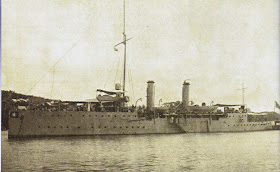I was in Singapore last week and on my way from the airport
to the hotel I saw a large banner-like announcement for an exhibition entitled “The
Zhongshan Warship” and its treasures.
I had not previously heard of this vessel but I was very keen to learn more. I
found it of great interest and in this blog I’d like to share something of it.
 |
| Poster |
The exhibition – which continues in Singapore until April
2015 – is organised by the Zhongshan
Warship Museum of Wuhan, China, and is
held in the Sun Yat Sen Nanyang Memorial Hall. This is housed in what was the residence
of one of Singapore’s most successful merchants and philanthropists in the late
19th and early 20th Century. Should you be visiting
Singapore it is well worth visiting this splendid museum even should the Zhongshan exhibition be finished. The museum covers not only the life of Sun Yat
Sen (1866-1925), the revolutionary who brought about the fall of the Manchu
(Qing) Dynasty in 1911 and who created the Chinese Republic that followed, but it
also tells the story of the rise of the great Chinese business empires centred
on Singapore. Sun’s story is dramatic in the extreme and I was not previously
aware just what a large role was played in the revolution by the Overseas
Chinese communities as regards funding and provision of support for political exiles
and activists. The museum is splendidly housed and the organisation and range
of exhibits make it a model of its kind.
The presence of the Zhongshan
exhibition at the museum is explained by the fact that the vessel, named after Sun
Yat Sen (his name in Mandarin being Sun Zhongshan), was strongly associated with
him, as well as with a number of other significant events in the years 1911-1937.
 |
| The splendid Sun Yat Sen Nanyang memorial Hall, Singapore |
Displacement: 830 Tons
Dimensions: 205 ft. long, 29.5 ft. beam and 15.3 ft.
draught
Crew: 108-140
Armament: 1 X
105 mm at bow, 4 X 47 mm along sides, 1X 40 mm aft
2
X 39 mm Anti-Aircraft weapons added in 1920s/30s
Machinery: 1350 hp triple expansion, twin screws, max
speed 13.5 knots.
 |
| Zhongshan, as seen in the 1920s or 30s |
The design was well suited to operation either in coastal
waters, or on China’s vast inland river system. By the time the Yongfen and her sister Yonhsiang were delivered the Imperial Government
had fallen. The new republic was to face many challenges, not least an attempt
by in 1915-16 by the first president, Yuan Shih Kai (1859-1916) to proclaim himself
emperor. Sun Yat Sen was a major force in frustrating this attempt. In the “Warlord
Period” which followed, in which central authority was challenged by local
strongmen who controlled vast areas with their private armies, naval units
allied themselves with the “Constitution Protection Movement” which was pledged
to defend the republic.
 |
| Sun Yat Sen and his wife, with crew, in 1922, when the Yongfen was his refuge |
In 1922 during further internal strife, Sun Yat Sen,
who was still actively attempting to unify the country, escaped danger by
taking refuge on the Yongfen for a
period of 55 days. This included running past the forts on the Pearl River,
close to Guangdong (Canton), which were controlled by the warlord Chen Jiong
Ming (1878-1933) with both Sun, and his protégée Chaiang Kai Shek on board. It
was to commemorate this that the vessel was renamed Zhongshan.
Under its new name the gunboat continued to have an active
career, which included coastal operations against pirates. In 1937 however, when
Japan invaded China (in what was essentially the opening of WW2, though few in the
west wanted to recognise this at the time) she was deployed in the Yangtze
River to oppose the Japanese advance westwards from Shanghai. On October 24th , near Wuhan, she
was attacked and sunk by six Japanese aircraft, the captain and 20 of the crew
being killed.
 |
| Hull seen on surface for first tine in almost 60 years |
 |
| Zhongshan refloated in 1997 - and in remarkably good condition |
The wreck was to lie undisturbed until 1996 when it was
resolved to raise and refurbish her as a
memorial to Sun. The hull appears to have been in remarkably good condition and
after an eight-man diving team removed some 1500 tons of silt from her it was
possible to raise her, between two barges, in February 1997. The hull was was winched on to a slipway for work to proceed on her and transported thereafter by means of a floating drydock to the custom-built viewing hall built for her near Wuhan. Final fitting out was done there, where she is now on permanent display.The photographs below give and idea of the very
comprehensive work involved.
 |
| Work in progress on slipway |
 |
| Completely restored hull en-route to the display hall near Wuhan |
 |
| Zhongshan being moved into display hall |
.jpg) |
| As Zhongshan is currently displayed |
The exhibition covers all aspects of the vessel’s history and
operation. There is a splendid 1:50 model and a large display of artefacts recovered
in good condition from the silt, which probably acted as a preservative. Seen together
they present a poignant view of what life would have been on board the Zhongshan as she patrolled the Chinese
coast and penetrated deep into the interior on the country’s massive rivers.
 |
| 1:50 model on display at exhibition |

.jpg)
What a remarkable restoration and exhibition. We in the West could learn a great deal from this (especially as we mourn the unnecessary loss of HMS Plymouth)
ReplyDelete